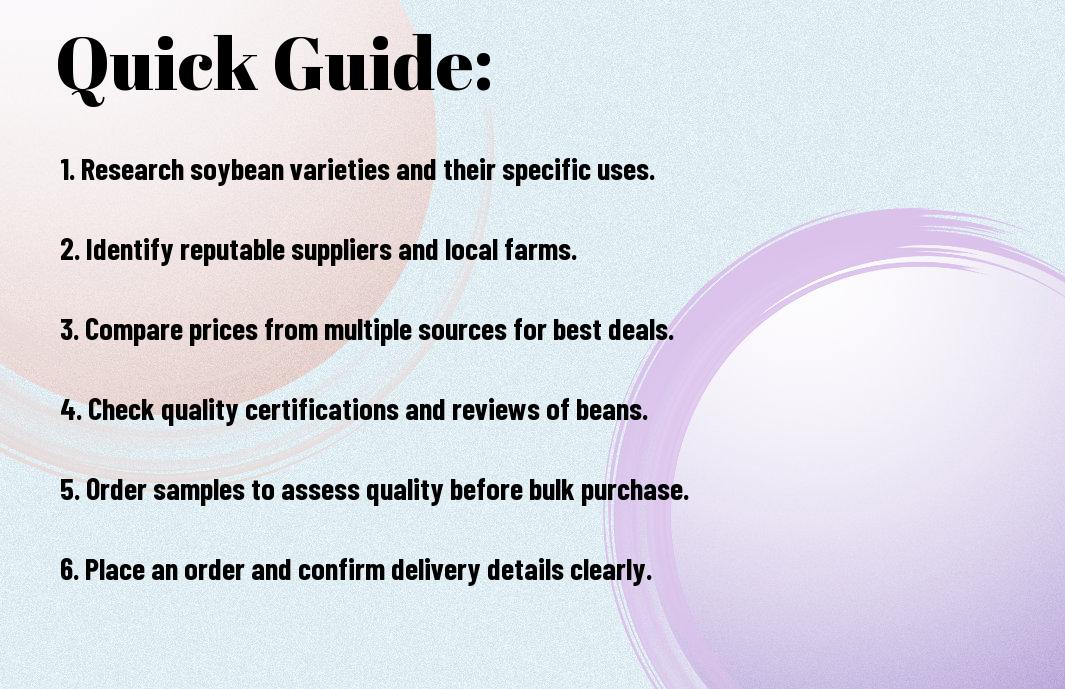There’s a lot to consider when you’re looking to buy soybeans, whether for personal use or business purposes. In this guide, you will discover the best practices for sourcing high-quality soybeans, how to navigate the market, and the factors that will impact your purchasing decisions. You’ll learn about trusted suppliers, different varieties, and the importance of considering both price and quality to ensure you receive the best beans possible. Let’s get started on your journey to sourcing the perfect soybeans!
Key Takeaways:
- Research and identify reputable suppliers that offer high-quality soybeans, considering factors like their sourcing practices and customer reviews.
- Understand different types of soybeans available in the market, such as food-grade and animal feed grade, to choose the best option for your needs.
- Evaluate pricing and shipping options to find the most cost-effective solution that meets your purchasing requirements and delivery timeline.

Types of Soybeans
While selecting soybeans, it’s necessary to understand the various types available in the market. Various forms cater to different needs based on their specific characteristics:
| Conventional Soybeans | Standard soybeans grown with traditional methods and common pesticides. |
| Organic Soybeans | Non-GMO soybeans grown without synthetic pesticides or fertilizers. |
| Non-GMO Soybeans | Type that has not been genetically modified, aimed at health-conscious consumers. |
| Edamame | Young, green soybeans that are typically eaten as a snack or appetizer. |
| Fermented Soybeans | Used in products like miso and tempeh, providing health benefits. |
Conventional vs. Organic
You might be deciding between conventional and organic soybeans. Conventional soybeans are often grown with the help of pesticides and genetically modified seeds, which can make them less expensive. In contrast, organic soybeans are cultivated without harmful chemicals, appealing to health-conscious consumers. Thus, choose based on your preferences for health standards and production methods.
Varieties and Their Uses
While there are numerous varieties of soybeans, each offers distinct benefits and uses. For instance, edamame is favored for snacking, while fermented varieties can enhance digestion and gut health. Other types serve critical purposes in cooking and food production.
Plus, understanding varieties and their uses allows you to make informed decisions. For instance, edamame is not only delicious but also packed with protein, making it an excellent choice for healthy diets. On the other hand, fermented soy products like miso provide additional flavor and beneficial probiotics. By knowing these details, you can better match your cooking and nutritional needs with the right soybean variety, ensuring your meals are both tasty and nutritious.
Tips for Sourcing Soybeans
Even when searching for the finest soybeans, you can enhance your sourcing process by considering these tips:
- Assess different soybean varieties.
- Evaluate your budget and purchase volume.
- Check for sustainability certifications.
- Utilize local producers when possible.
- Stay informed about market prices.
Recognizing these factors can lead you to high-quality soybeans.
Identifying Reputable Suppliers
Any successful sourcing strategy hinges on identifying reliable suppliers. Look for businesses with a strong track record, positive customer reviews, and appropriate certifications. You should also seek recommendations and conduct thorough research to ensure that you are partnering with viable, trustworthy sources.
Understanding Market Trends
Understanding the dynamics of the soybean market is crucial for maximizing your purchase potential. You must stay updated on various factors, including seasonal changes, demand fluctuations, and government policies affecting pricing.
Another method to gain insight into soybean market trends is to analyze historical data and follow industry reports. Engaging with experts and utilizing market analysis tools can further help you understand price volatility and emerging trends. Be cautious of speculative risks, and seize opportunities to make informed purchasing decisions that can positively impact your business outcomes.

Step-by-Step Guide to Purchasing Soybeans
Keep the following steps in mind to successfully purchase soybeans that meet your needs:
| Step | Description |
|---|---|
| 1. Research Market Prices | Investigate current prices to determine a fair value. |
| 2. Identify Suppliers | Look for reputable sources for high-quality soybeans. |
| 3. Compare Options | Evaluate various suppliers in terms of price, quality, and availability. |
| 4. Placing Your Order | Finalize your choice and purchase the soybeans. |
Researching Market Prices
You should start by consulting commodity price websites or industry reports to gather the most current market prices for soybeans. This information will provide you with a baseline to assess whether the prices offered by your potential suppliers are reasonable and competitive.
Placing Your Order
Guide your selection process by ensuring that you’ve chosen the best supplier according to your research before placing your order.
Soybeans are available from various sources, including local farms, agricultural cooperatives, and online platforms. When making your purchase, check for bulk ordering options that can lead to cost savings. Always clarify shipping terms and ensure that the beans meet your quality standards. Additionally, consider checking reviews or requesting samples to assess quality. This thorough approach helps ensure you get exactly what you pay for and minimizes any potential issues.
Factors to Consider When Buying Soybeans
Once again, when sourcing soybeans, it’s important to assess various factors that can impact your purchase. Consider the following:
- Quality
- Price
- Source
- Variety
- Demand
The right combination of these elements will ensure you make an informed decision that aligns with your needs.
Quality Standards
The quality of soybeans plays a significant role in your buying decision. Look for beans that meet specific grading standards, ensuring they are free from contaminants and have a high germination rate. Opt for beans that have been tested for pests and diseases to guarantee optimal performance if you intend to plant them.
Pricing and Budget
Factors influencing the price of soybeans can greatly affect your overall budget. Keep in mind seasonal trends, market fluctuations, and your specific supplier’s price range when making your purchasing decision.
Quality soybeans can be a long-term investment, but comparison shopping is key. Prices can vary depending on the source, quality, and availability. Set a clear budget but be flexible to adapt based on the demand in the market. Always aim for a balance between affordability and quality to ensure the best return on your investment.
Pros and Cons of Buying Soybeans
All potential buyers should weigh the advantages and disadvantages of purchasing soybeans to make informed decisions. Below is a breakdown of the pros and cons you may encounter.
| Pros | Cons |
|---|---|
| High nutritional value | Price volatility |
| Versatile ingredient | Quality variation among suppliers |
| Demand in various industries | Storage and shelf-life considerations |
| Potential for local sourcing | Regulatory compliance requirements |
| Supports sustainable agriculture | Import/export complexities |
Advantages of Sourcing Quality Beans
Soybeans are a valuable and versatile crop, offering numerous health benefits and uses across various culinary and industrial applications. By sourcing quality beans, you can ensure superior taste, enhanced nutritional profiles, and improved resilience during processing. This not only supports your business but also contributes to sustainable agricultural practices, amplifying your impact in the market.
Potential Challenges in the Buying Process
Advantages of sourcing soybeans come with their own set of challenges that require your attention. Factors such as inconsistent quality from suppliers and price volatility can impede your purchasing process. Additionally, understanding storage needs and compliance with regulatory standards may pose difficulties, especially if you’re new to the market. It’s important to thoroughly research potential suppliers and seek reliable brands to mitigate these issues.
This attention to detail can safeguard your investments and maintain the quality of your final products. Be vigilant about supplier reliability and price trends to secure your place in the market effectively.

Frequently Asked Questions
Unlike other commodities, buying soybeans can come with specific challenges and nuances. It’s common to see potential buyers confused about where to start, how prices are set, and the difference between conventional and organic options. In this section, we address these questions to help you make informed decisions.
Common Concerns About Purchasing
The most frequent concerns when purchasing soybeans include quality assurance, price fluctuations, and sourcing reliability. Buyers often worry about receiving subpar products or being taken advantage of due to market conditions. It’s important to research suppliers and ask questions to alleviate these concerns.
Tips for First-Time Buyers
Even if this is your first time buying soybeans, you can navigate the process successfully with a few key strategies:
- Identify reliable suppliers who offer quality products.
- Compare prices from multiple sources to ensure a fair deal.
- Understand the differences between organic and conventional soybeans.
The insights you gain will help you make informed choices about your purchases.
Purchasing soybeans for the first time doesn’t have to be daunting. Conduct thorough research on potential suppliers and always seek reviews or testimonials. Establishing communication with your supplier will help you feel comfortable and confident in your decisions. You can also consider bulk buying or joining a cooperative to secure better pricing and quality.
- Assess your needs based on consumption or resale.
- Verify the certification if choosing organic soybeans.
- Stay updated on market trends to anticipate price changes.
The more prepared you are, the smoother your purchasing experience will be.
Conclusion
Upon reflecting, you now have the knowledge to effectively source the best soybeans for your needs. By understanding the different types of soybeans, assessing quality indicators, and identifying reliable suppliers, you can make informed decisions that suit your requirements. Utilize online platforms, local farmers, and cooperative resources to expand your options. With this guide, you are well-equipped to navigate the soybean market and find the right beans for your agricultural or culinary pursuits.
FAQ
Q: What are the best places to buy soybeans?
A: Soybeans can be sourced from various places including local farms, agricultural supply stores, and online retailers. Additionally, consider joining co-ops or farmer’s markets to connect directly with growers. Websites such as Amazon and specialty seed suppliers also offer diverse options.
Q: How do I choose the right type of soybean for my needs?
A: When opting for soybeans, consider factors such as the intended use (edible, oil production, or animal feed), climate suitability, and growth time. Research different varieties, such as non-GMO, organic, or traditional hybrids, and read reviews or consult with local agricultural extension services for guidance.
Q: What should I look for in the quality of soybeans?
A: Quality soybeans should be uniform in size, free of mold, insects, and foreign materials. Look for signifiers such as certification labels, especially if you are interested in organic or non-GMO products. Additionally, fresh beans should have a firm texture and a pleasant aroma.
Q: Is it possible to buy soybeans in bulk, and what are the advantages?
A: Yes, buying soybeans in bulk is often possible through wholesalers and agricultural suppliers, which can lead to significant savings. Bulk purchases also offer the advantage of having a consistent supply for larger projects or ongoing use, and may provide options for customized orders depending on your specific requirements.
Q: What are the storage requirements for soybeans after purchase?
A: After purchasing soybeans, they should be stored in a cool, dry place to prevent spoilage. Use airtight containers to keep out moisture and pests, and check regularly for any signs of deterioration. Proper storage can extend the shelf life of your soybeans significantly and maintain their quality.
